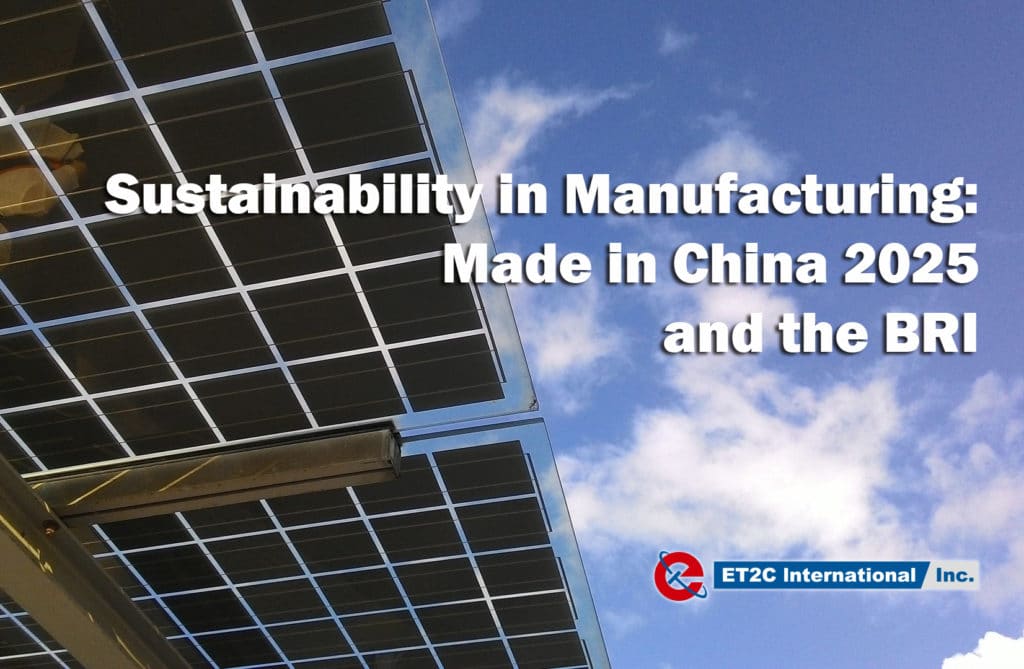Sustainable manufacturing is becoming one of the key criteria for consumers when deciding what product to use. The process of sustainable manufacturing includes the creation of products through economically sound practices that limit the negative impacts on the environment. Consumer opinions, regulatory policies, and changing environmental conditions are all factors that have led to the emergence of sustainable manufacturing as a popular, profitable, and viable option for manufacturers that are seeking to capitalize on the green economy, minimize their impact on the environment, and reduce their consumption of energy and resources.
Made in China 2025 and Sustainability
Chinese manufacturers find themselves in a transitional period. The country is no longer the best location for cheap, low cost manufacturing, but it has not fully evolved into a high-tech, developed industrial economy. China is making great developments in its industry with new additions of automation and robotics in the factories, but there is still a lot of ground to cover. China is feeling pressures from both more developed industrial bases as well as more labour intensive export manufacturing regions. In order to overcome these challenges, China has launched the Made in China 2025 initiative to bring the Chinese economy to the cutting edge and make a high-tech, sustainable manufacturing base.
In the process of developing their manufacturing into a high-tech, automated industry, China is also investing in the creation of sustainable manufacturing. By relying on and using AI, and the digital economy, China is transitioning their manufacturing base to a modern, developed economy. This also reduces the use of heavy industry and relies more on mass customization consumption and makes use of Industry 4.0 practices, thus making this method of manufacturing more sustainable.

Can the Digital Economy Keep the Belt and Road Initiative Sustainable?
One of the key areas where China is experiencing conflict between development and sustainability is with the “Belt and Road” initiative (BRI). Globally, the BRI has received criticism and has been questioned about its sustainability and the long-term impact that it will have on the environment. However, in 2017, President Xi Jinping addressed some of these concerns by announcing that cutting-edge technologies and business practices from the 4th Industrial Revolution are being brought to the BRI.
President Xi Jinping said, “We should pursue innovation-driven development and intensify cooperation in frontier areas such as digital economy, artificial intelligence, nanotechnology and quantum computing, and advance the development of big data, cloud computing and smart cities so as to turn them into a digital silk road of the 21st century.” The “Digital Silk Road” could bring new green technologies and sustainable manufacturing practices to emerging markets. This would help lay the ground work for the development of a more sustainable, and environmentally-conscious global market in the future.
The BRI/Digital Silk Road and the Made in China 2025 initiatives are efforts working towards creating a sustainable digital economy that can bring new opportunities to small and medium global actors, incorporate new markets into the global economy, develop high-tech manufacturing bases, and employ sustainable economic practices.
Green Manufacturing in China
Green manufacturing is a key development and a central trend in China’s transitioning manufacturing sector. Moving forward with the Made in China 2025 initiative and the BRI, along with the global environmental and economic forces, manufacturing in China will make a significant shift to become a potential leader in green manufacturing and sustainable industry.
The 4th Industrial Revolution, Made in China 2025, and sustainable manufacturing all pair well together. The digital aspects of the 4th Industrial Revolution and the automation of manufacturing in Made in China 2025 can reduce the waste, energy consumption, and environmental cost of production. Xin Guobin, vice-minister of the Ministry of Industry and Information Technology said that “Green Manufacturing Association of China will also explore a new development mode by connecting green manufacturing and the internet and establish a green manufacturing system and ecosystem for the country’s green and sustainable development.” By using the Internet of Things and modern software to connect the manufacturing process at all stages waste can be cut down and the production process will be more sustainable in the long term.

Sustainable manufacturing is not only a trend in China, but also globally. For example, there has been an emergence of innovative sustainable manufacturers outside of China in countries like Vietnam and Indonesia (industries such as apparel). In order to remain competitive within the global economy, China needs to continue this evolution to maintain its value proposition to Global retailers and Brands. The initiatives set out by the Government only go to build on the environmental inspections carried out in 2017 and also accelerate investment in sustainability on a broader scale. China therefore has one of the fastest growing sustainable manufacturing sectors and it is a great location for foreign businesses seeking to outsource their production to ethical and sustainable manufacturers.


